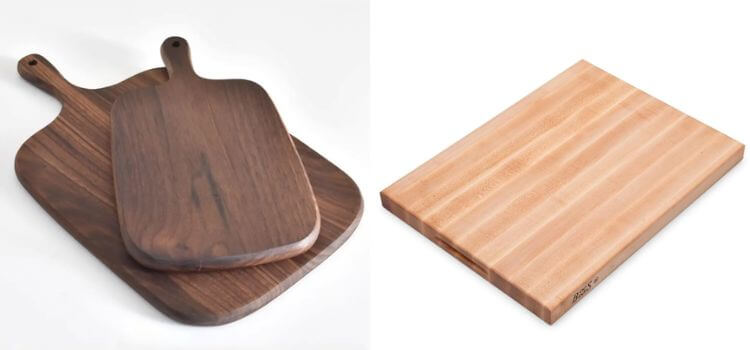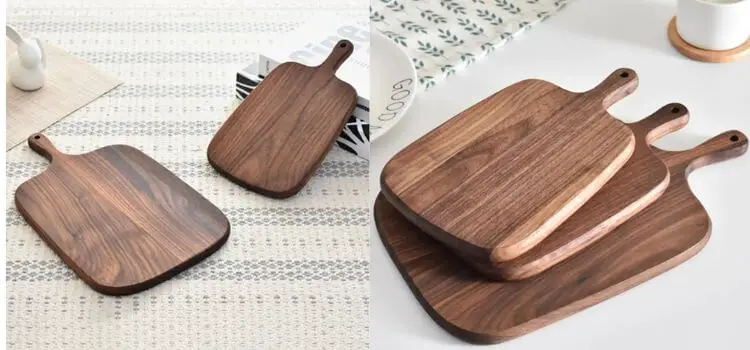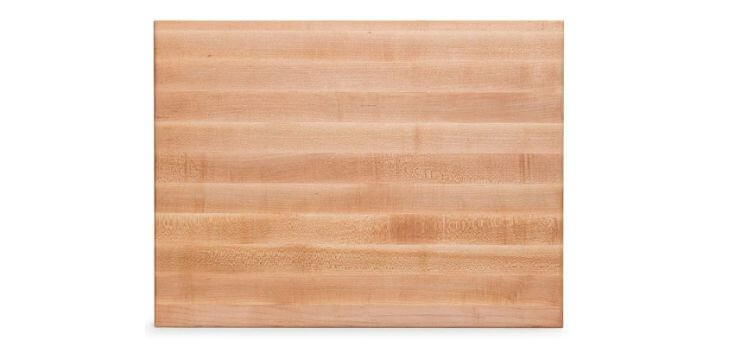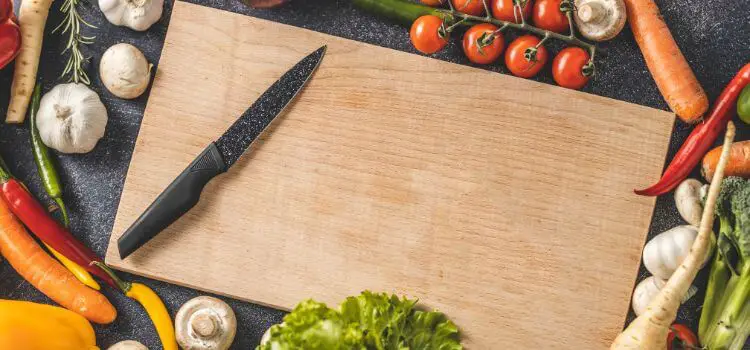As an Amazon Associate, I earn from qualifying purchases

When selecting the ideal cutting board for your kitchen, the debate between walnut and maple boards often arises. Walnut and maple cutting boards each possess distinct qualities that cater to various culinary needs.
This article examines the unique qualities of walnut and maple cutting boards, focusing on their durability, maintenance demands, aesthetics, and overall performance.
Whether you’re a seasoned chef or a home cook looking to elevate your kitchen experience, understanding the differences between walnut and maple cutting boards will help you make an informed decision for your culinary endeavors.
Walnut Cutting Boards

Walnut cutting boards are known for their durability and strength. This dark hardwood’s natural resistance to bacteria makes it an ideal, hygienic choice for food preparation.
Unlike other woods, walnut has a closed-grain structure, meaning it does not have open pores that can harbor bacteria. This makes cleaning and maintaining a walnut cutting board relatively easy.
In addition to its functionality, walnut is a beautiful and elegant wood that adds a touch of sophistication to any kitchen. Each board’s deep, rich color and unique patterns make it truly one-of-a-kind.
Pros and cons of using walnut cutting boards
Pros:
- Durable and strong
- Naturally resistant to bacteria
- Easy to clean and maintain
- Elegant and unique aesthetic qualities
Cons:
- More expensive than other wood options
- It may show knife marks more prominently.
Basic statistics of walnut cutting boards:
- Average cost: $50-$150
- Average lifespan: 5-10 years
Maintenance of walnut cutting boards
- Clean the board with warm, soapy water after each use.
- Dry the board thoroughly to prevent warping or cracking.
- Use mineral oil to preserve its luster and shield it from moisture.
- Refrain from soaking the board in water.
Maple Cutting Boards

Maple cutting boards are a favored choice among both professional chefs and home cooks. Renowned for its strength and durability, this light-colored hardwood is an excellent choice for heavy-duty cutting tasks.
While Maple has a similar closed-grain structure to walnut, it is slightly more porous. Proper maintenance are essential to prevent bacteria from growing on the board’s surface.
Maple also offers versatility when it comes to aesthetics. It can be found in various shades, from light cream to a deeper reddish-brown, and its smooth surface allows for intricate designs to be carved into the wood.
Pros and cons of using maple cutting boards
Pros:
- Strong and durable
- Versatile in terms of aesthetics
- Resistant to knife marks
- Affordable option
Cons:
- Necessitates regular cleaning and upkeep to inhibit bacterial growth
- Can be prone to warping if not cared for properly
Basic statistics of maple cutting boards:
- Average cost: $30-$80
- Average lifespan: 3-5 years
Maintenance of maple cutting boards
- Clean the board with warm, soapy water after each use to remove food particles and residue.
- Thoroughly dry the board with a clean towel to prevent warping or cracking, ensuring it stays in excellent condition.
- Apply a generous amount of mineral oil once a month to maintain its natural shine and provide a protective barrier against moisture.
- Sand down any knife marks or scratches using fine-grit sandpaper to maintain a smooth and even surface, prolonging the board’s lifespan.
A Comparison: Walnut vs Maple Cutting Board

Both walnut and maple cutting boards have unique qualities, making them suitable for different purposes.
- Durability: Walnut is known for its strength and resistance to bacteria, while Maple offers durability and resilience in heavy-duty cutting tasks.
- Maintenance: While both require regular maintenance with warm, soapy water and mineral oil, walnut may be slightly easier to clean due to its closed grain structure.
- Aesthetics: Walnut offers a dark, rich color and unique grain patterns, while Maple offers versatility with its various shades and smooth surface for intricate designs.
- Performance: Both walnut and Maple are reliable options for cutting tasks, with walnut being more resistant to knife marks and Maple offering resilience in heavy-duty use.
- Hygienic: Both walnut and Maple have a closed-grain structure, making them resistant to bacteria. However, thorough cleaning and regular maintenance are essential to prevent bacterial growth on the surface.
Choosing the Right Cutting Board
Factors to consider when selecting between walnut vs maple cutting board:
- Usage: Consider the type of cooking and cutting tasks you’ll be using the board for. Maple may be better if you require a durable and resilient board for heavy-duty tasks. However, if aesthetics are a priority, walnut’s unique grain patterns make it an excellent choice.
- Budget: Walnut cutting boards are generally more expensive than Maple, so consider your budget before deciding.
- Average lifespan: Both walnut and maple cutting boards have a lifespan of about 5-10 years and 3-5 years, respectively. Consider how often you plan to replace your cutting board when deciding.
- Style preference: Both walnut and Maple offer their unique aesthetic qualities, so choose the one that complements your kitchen’s overall style.
Recommendations based on specific needs and preferences:
- For durability: Opt for a maple cutting board for heavy-duty use and durability.
- For aesthetics: If you want to add an elegant touch to your kitchen, go for a walnut cutting board.
- For a budget-friendly option, Maple is more affordable than walnut.
Conclusion
Walnut and maple cutting boards each possess distinct qualities, making them ideal for various purposes. While walnut offers durability and a touch of elegance, Maple is known for its strength and versatility in aesthetics.
Ultimately, choosing between the two will hinge on your unique needs and preferences. With proper care and maintenance, both cutting boards can last for years and be a reliable tool in your culinary endeavors. So, whether you choose walnut or Maple, you can’t go wrong. Happy cooking!
As an Amazon Associate, I earn from qualifying purchases